Contents
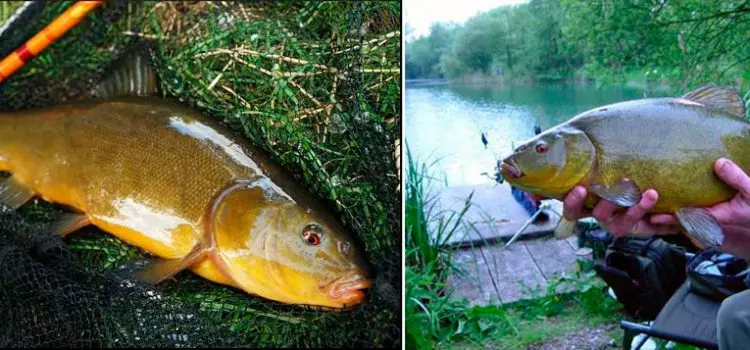
Tench fishing is exciting, because not everyone manages to catch a tench, this fish leads a hidden lifestyle, adheres to certain areas of the bottom, feeds selectively and is rarely on the hook. But the fisherman who has studied the water well and knows the habits of the tench will always be able to catch the tench; it is important to get in the right weather, be observant and experiment with nozzles and baits. The easiest way to catch a tench is during its active biting. The beginning of the summer feeding activity of the tench is largely due to its spawning, which occurs at a temperature of +20 C. This water temperature in the reservoirs of Central Russia usually occurs at the end May – early June. Therefore, taking into account the fact that the fish is sick for some time after spawning, and then begins to actively replenish lost calories, the peak of the tench biting falls on the beginning or middle of summer.
Where to catch tench?
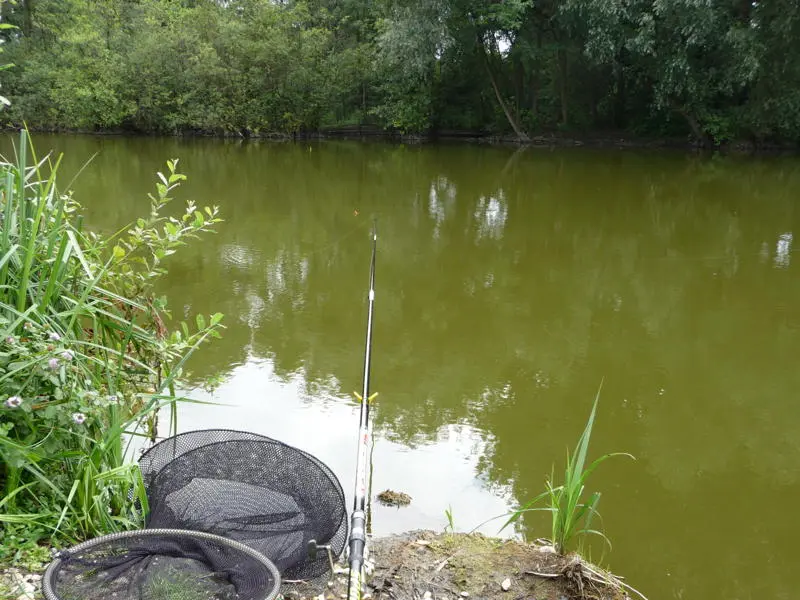
The difficulty of choosing a place where to catch a tench is due to the fact that the tench does not gather in large flocks. In spring tench forms pairs, and after spawning large tench prefers to stay alone. Sometimes you can find areas where a small tench pecks quite often, apparently they are attracted to food here.
Where is the best place to catch tench? As a rule, on rivers, lakes and ponds, this fish chooses muddy backwaters, backwaters, creeks with a lot of algae for its habitat. In reservoirs with low-flowing water, such places can be far from the shore, so here you have to fish from a boat, throwing a float equipment under the edge of the algae.
Tench likes to stay above a hard bottom with a small layer of silt. Horsetail thickets can be found on such soil, and it is here that tench most often wanders in search of food. Sometimes you can see how the horsetail stalks sway in the direction of the fish. It is better to catch tench in such places.
Where else is it good to catch tench, this is in creeks and backwaters that are attractive to tench, which hide under water during floods and are washed by a strong stream, and then, when the water subsides, they again turn into stagnant areas, fresh organic matter begins to gradually accumulate in them, in which the tench finds food for itself : nymphs, various kinds of worms, small crustaceans and other organisms. The tench almost always feeds on animal food, with the exception of young shoots of algae in early summer. Because the tench likes to dig in the silt, it can be detected by the bubbles that appear on the surface of the water.
When to catch tench?
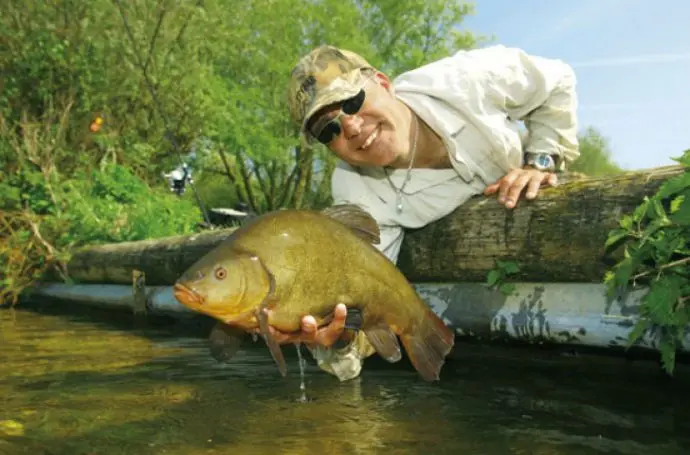
In June, the best time for line fishing is morning – from 7 to 9 o’clock. A good biting can resume in the evening. During the day, episodic feeding. This is due to the fact that, going out to feed, lines usually follow each other along the same route, adhering to the edge of algae bordering open areas of water. Day and night they move away from the shore or hide in thick grass, and in the evening they begin to move along the edge of the algae in the opposite direction, again looking for food.
Example: How to catch tench on Lake Pleshcheyevo. The lake is very deep, but its shallows are overgrown with reeds almost everywhere. Where a young reed sprouts in front of a strip of old reed (usually a strip 10–15 m wide), anglers mow small spots in advance, connect them with each other by a path that allows the tench to move along a given route. They do not mow the windows completely, but if possible leave the vegetation, but so that it does not interfere with fishing. A good option is when natural clearings found among vegetation are interconnected by a trampled path.
Tench fishing is often accompanied by the bite of other fish. On the Yauzskoe reservoir, near the village of Orzhaniki, at the beginning of summer, the tench prefers to stay near the strip of coastal algae and wanders along it in search of food. In well-fed places, he pecks interspersed with perch, roach and bream. In order to weed out small fish and catch measuring lines, you often have to use a larger nozzle.
What to catch tench?
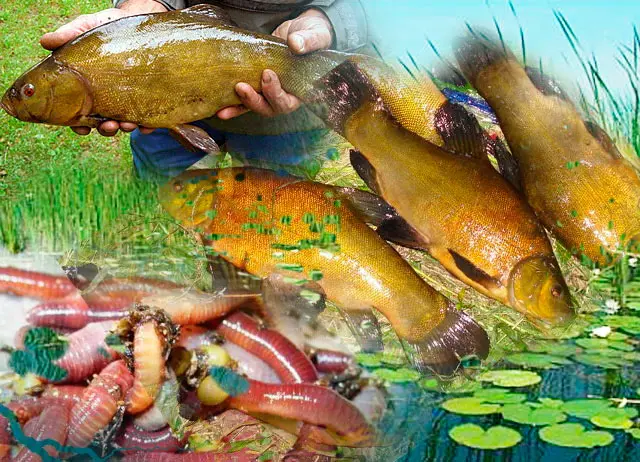
At the beginning of summer, the tench is not yet very picky in nozzles and you can catch tench with live bait. It stays with algae in places where insects exit. It is better to catch tench using caddis flies, dragonflies, stoneflies, and mosquitoes as bait. You can also catch tench with amphipods, small leeches, etc. At this time, the fisherman should carefully observe the processes taking place in the reservoir and, focusing on natural baits that are easily accessible to fish, combine them with vegetable ones. In general, just like when fishing for crucian carp, an angler in a pond should always have an assortment of baits: about three baits of animal and vegetable origin. Since the end of June, the tench biting is no longer so active.
And the question of what is better to catch a tench is especially acute, because catching a tench becomes random. However, experimenting with the season and here gives its results. Much depends on the temperature of the water and its saturation with oxygen. On the rivers, the picture is one, on low-flowing reservoirs – another. It often happened that, getting into the backwaters of the river, where there is a lot of tench, no matter how much I threw at the worm, everything pecked at him, but not the tench. Fishing was one-day, so it was not possible to use a long-term bait. I tried to catch tench on bloodworms and maggots – the result was the same. What is the best way to catch tench in such cases.
A small rudd, a perch, a roach pecked at the worm, apparently, it did not allow the tench to peck. And in such cases, with the whims of tench fish, it is better to catch steamed barley. Once I managed to catch a dozen measuring lines on this nozzle on one small dam. Barley planted one or two grains on the corresponding hook with a short forearm. He released the float so that the nozzle was located 3-5 cm from the ground.
Lin pecked at her without thinking. And the small roach, of which there were many, did not annoy at all. As for catching tench on a worm, many use a purchased red worm, but the tench is very sensitive to foreign odors that an artificially bred worm can have. If you are already trying to catch a tench for a worm, take, say, not a dendrobene of an industrial blank (since it is not clear how it was harvested and whether it has a foreign smell from an unwashed tool), and right there on the shore to dig up ordinary earthworms, on which catching tench is a pleasure.
On rivers, dams and small lakes, it is better to catch tench using a caddisfly as a nozzle.
In many reservoirs, in order to cut off a trifle, it is better to catch tench on bulk baits, such as pickled corn, and where there are very large lines, even crawl out.
Bait for tench

To stably catch a tench, you need to bait it for a long time, using bait. The best bait for tench is chopped worm mixed with coastal soil. When the tench gets used to the feed, it begins to regularly pull itself up to it from distant corners (usually in the evening). A high concentration of fish in the place of fishing encourages the tench to feed very actively, keeping the small things away. When using a one-day bait for tench, you need to dose it correctly. No need to get carried away with bait with a large number of components. Multicomponent prikormki attract a lot of little things. And as soon as you start to carry a trifle, it alarms the tench and it stops pecking.
- Dry mixes are also suitable for bait. For example, the domestic “Team Fighter”, you can add coastal soil in a certain amount to make the food look natural. It is desirable to avoid imported baits for tench, as they are oversaturated with flavors, and tench is very suspicious of smells. It is best to take a fertile layer of molehills for bait on tench. The earth has already been sifted in them, it is not necessary to dig it and it smells like worms, and therefore the fish like it.
- Another version of a simple bait – This is a homemade bait. Soak fresh rye bread and knead it with a large amount of sifted coastal soil. White bread is not good, it attracts a lot of small things. Moreover, tench responds well to a more acidic product. No wonder in the days of L.P. Sabaneev, this mysterious fish was fed with cottage cheese (it contains lactic acid). And most importantly, why cottage cheese was used – a trifle does not like an sour product.
- Bait for tench do it yourself consists of the following components:
- coastal land – 75-80%;
- rye bread (crackers cooked in the oven, ground in a meat grinder) – 7-8%;
- hercules (fried in a pan until pink and ground in a coffee grinder) – 7-8%;
- roasted and ground hemp (cannabis can be replaced with oilcake or roasted seeds, but at the same time you do not need to add all the components to the bait) – 7-8%.
- In Ukraine and other southern regions there are many reservoirs in which using peas as bait for tench, luring with pea porridge. So that the best bait for tench, where tench is to taste, is made according to the recipe: you can grind peas in a meat grinder, fry it in a pan until pink and add it to the above bait instead of hercules. For the nozzle, boil chopped peas in a saucepan over low heat; stir so that the porridge does not burn, and then knead thoroughly so that the plucked pieces hold well on the hook.
Tackle for tench and fishing technique
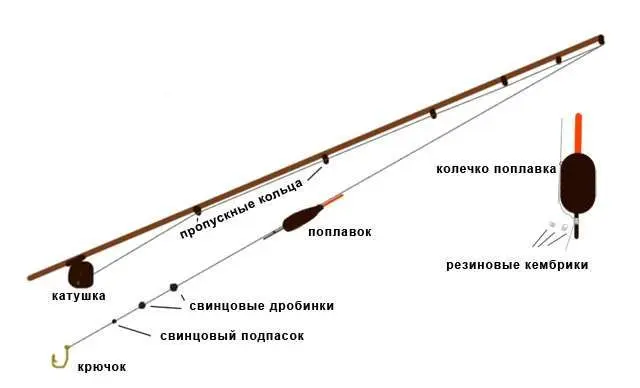
The line should be caught on a float rod so that the nozzle is located close to the silt or a little higher, say, at a height of 15–20 cm. To accurately set the fishing depth, it is very important to determine how deep the sinker goes into the silt. Without bait, tench is often caught halfway. This is especially true for the period of release of insects. Tackle for tench is used like Bolognese with light equipment. Tench is a strong fish and it is difficult to bring it out without a reel.
And he does not always take on rough tackle. The float should have a carrying capacity of 1,5 to 2,5 g with a short, elongated keel, since you usually have to fish in calm water and at depths of 1 to 2,5 m. The quieter the float lies on the water, the better, all of – because tench is a fish suspicious of extraneous sounds. In this regard, self-loading floats are not very suitable, as they splash too noisily on the water. For tench, it is quite possible to take a foam spindle-shaped float. Loading – two pellets: the main one is placed 30 cm from the leash, and the minimum weight of the shepherd is attached at the leash itself (its length is 20–25 cm), this allows the nozzle to go to the bottom more slowly, and the line notices the planning nozzle faster. The hook is taken in size equal to the nozzle No. 8–18.
Bite and fight
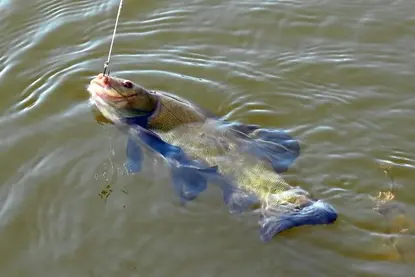
At the beginning of summer, the tench often bites confidently, almost like a perch. Later, having eaten, he begins to savor the nozzle for a long time. In this case, the float, before going to the side, can stagnate in place for up to 15 minutes. On pearl barley, the tench always takes actively. Tench is very athletic: resisting, he will press into the bottom, stronger than the ide, and then, when fighting, he walks in circles. It is very difficult to catch it in reed windows. Resting, he twists the fishing line by the algae, and when you pull, you can see how a mixture of mud and silt rises from the bottom. This is because he is trying to burrow into the mud.
You need to pull the line gently, not letting it go deep into the mud, for this the whip of the rod should be of medium hardness, and it is better to take the rod with a fast action. If the tackle is unreliable, after taking the line, one or two minutes – and farewell to the equipment. Even for catching 200-300-gram lines, roach tackle in strong places is not suitable. An 800-gram tench resists in the same way as a two-kilogram carp, but it will be easier to deal with carp. It is very difficult to catch tench in water lily burdocks, resisting, tench strives to wrap them with fishing line. Under any conditions of fishing near algae, a fishing line thinner than 0,16 mm should not be set. In this case, the monofilament must be taken of the highest quality.
After a stormy fight, even in a privileged place, you have to wait a long time for the next approach of this fish. Therefore, it is better to go to a pre-baked spare point.
When catching tench, it is important to observe disguise, since a cautious tench will never come to the place if the fisherman is on the open bank, and the depth is no more than two meters. Bright clothing for fishing should be avoided. It is advisable to camouflage behind coastal vegetation.









